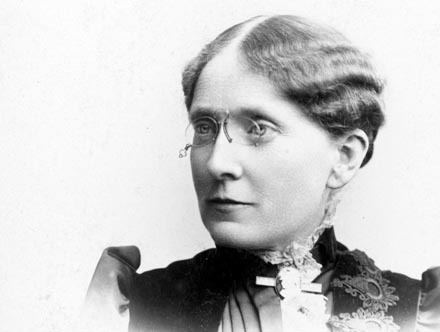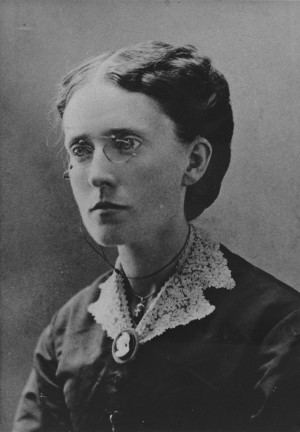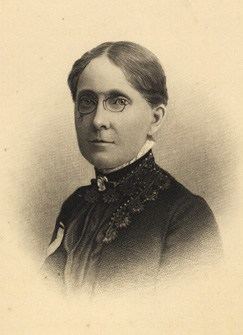Cause of death Influenza Role Suffragist Name Frances Willard | Religion Methodist Nationality American | |
 | ||
Full Name Frances Elizabeth Caroline Willard Born September 28, 1839 ( 1839-09-28 ) Churchville, New York Occupation University Dean; political reformer; women's suffragist Died February 18, 1898, New York City, New York, United States Known for Woman's Christian Temperance Union Books How I learned to ride the bi, A classic town, A wheel within a wheel, Let something good be s, Woman in the pulpit Similar People Carrie Nation, Mary Liver, Carrie Chapman Catt, Susan B Anthony, Elizabeth Cady Stanton | ||
Frances Elizabeth Caroline Willard (September 28, 1839 – February 17, 1898) was an American educator, temperance reformer, and women's suffragist. Her influence was instrumental in the passage of the Eighteenth (Prohibition) and Nineteenth (Women Suffrage) Amendments to the United States Constitution. Willard became the national president of Woman's Christian Temperance Union (WCTU) in 1879, and remained president until her death in 1898. She developed the slogan "Do Everything" for the WCTU, encouraging its membership to engage in a broad array of social reforms through lobbying, petitioning, preaching, publishing, and education. Her vision encompassed raising the age of consent, labor reforms such as the eight-hour work day, prison reform, scientific temperance instruction, Christian socialism, and the global expansion of women's rights.
Contents
- Illinois adventure 1406 frances willard house
- Biography
- Memorials and portrayals
- Relationships
- Controversy over Civil Rights Issues
- Publications
- References
Illinois adventure 1406 frances willard house
Biography

Willard was born in 1839 to Josiah Flint Willard and Mary Thompson Hill Willard in Churchville, near Rochester, New York. She was named after English novelist Frances (Fanny) Burney, the American poet Frances Osgood, and her sister, Elizabeth Caroline, who had died the previous year. She had two other siblings: her older brother, Oliver, and her younger sister, Mary. Her father was a farmer, naturalist, and legislator. Her mother was a schoolteacher. In 1841 the family moved to Oberlin, Ohio, where, at Oberlin College Josiah Willard studied for the ministry, and Mary Hill Willard took classes. They moved to Janesville, Wisconsin in 1846 for Josiah Willard's health. In Wisconsin, the family, formerly Congregationalists, became Methodists. Frances and her sister Mary attended Milwaukee Normal Institute, where their mother's sister taught.

In 1858, the Willard family moved to Evanston, Illinois, and Josiah Willard became a banker. Frances and Mary attended the North Western Female College (no affiliation with Northwestern University) and their brother Oliver attended the Garrett Biblical Institute.

After graduating from North Western Female College, Willard held various teaching positions throughout the country. She was appointed president of the newly founded Evanston College for Ladies in 1871. When the Evanston College for Ladies became the Woman's College of Northwestern University in 1873, Willard was named the first Dean of Women at the university. However, that position was to be short-lived with her resignation in 1874 after confrontations with the University President, Charles Henry Fowler, over her governance of the Woman's College. Willard had previously been engaged to Fowler and had broken off the engagement.

After her resignation, Willard focused her energies on a new career: the women's temperance movement. In 1874, Willard participated in the founding convention of the Woman's Christian Temperance Union (WCTU) where she was elected the first Corresponding Secretary. In 1876, she became head of the WCTU Publications Department, focusing on publishing and building a national audience for the WCTU's weekly newspaper, The Union Signal. Willard joined with Elizabeth Boynton Harbert, Mary Ellen West, Frances Conant. and 43 others in 1885 in the founding the Illinois Woman's Press Association.
In 1879, she sought and successfully obtained presidency of the National WCT. Once elected, she held the post until her death. Her tireless efforts for the temperance cause included a 50-day speaking tour in 1874, an average of 30,000 miles of travel a year, and an average of 400 lectures a year for a 10-year period, mostly with the assistance of her personal secretary, Anna Adams Gordon.
As president of the WCTU, the crux of Willard's argument for female suffrage was based on the platform of "Home Protection," which she described as "the movement … the object of which is to secure for all women above the age of twenty-one years the ballot as one means for the protection of their homes from the devastation caused by the legalized traffic in strong drink." The "devastation" she was referencing was the prevalence of violent acts against women committed by intoxicated men, both in and outside the home. Willard argued that it was too easy for men to get away with their crimes without women's suffrage. The "Home Protection" argument was used to garner the support of the "average woman," who was told to be suspicious of female suffragists by the patriarchal press, religious authorities, and society as a whole. The desire for home protection gave the average woman a socially appropriate avenue to seek enfranchisement. Willard insisted that women must forgo the notion that they were the "weaker" sex and that they must embrace their natural dependence on men. She encouraged women to join the movement to improve society: "Politics is the place for woman." The goal of the suffrage movement for Willard was to construct an "ideal of womanhood" that allowed women to fulfill their potential as the companions and counselors of men, as opposed to the "incumbrance and toy of man."
Willard's suffrage argument also hinged on her feminist interpretation of Scripture. She claimed that natural and divine laws called for equality in the American household, with the mother and father sharing leadership. She expanded this notion of the home, arguing that men and women should lead side by side in matters of education, church, and government, just as "God sets male and female side by side throughout his realm of law."
Willard's work took to an international scale in 1883 with the circulation of the Polyglot Petition against the international drug trade. She also joined May Wright Sewall at the International Council of Women meeting in Washington, DC, laying the permanent foundation for the National Council of Women of the United States. She became the organization's first president in 1888 and continued in that post until 1890. Willard also founded the World WCTU in 1888 and became its president in 1893. She collaborated closely with Lady Isabel Somerset, president of the British Women's Temperance Association, whom she visited several times in the United Kingdom.
After 1893, Willard was influenced by the British Fabian Society and became a committed Christian socialist.
Willard died quietly in her sleep at the Empire Hotel in New York City after contracting influenza while she was preparing to set sail for England and France. She is buried at Rosehill Cemetery, Chicago, Illinois She bequeathed her Evanston home to the WCTU. The Frances Willard House was opened as a museum in 1900, when it also became the headquarters for the WCTU. In 1965 it was elevated to the status of National Historic Landmark.
Memorials and portrayals
The famous painting, American Woman and her Political Peers, commissioned by Henrietta Briggs-Wall for the 1893 Chicago Columbian Exposition, features Frances Willard at the center, surrounded by a convict, American Indian, lunatic, and an idiot. The image succinctly portrayed one argument for female enfranchisement: without the right to vote, the educated, respectable woman was equated with the other outcasts of society to whom the franchise was denied.
After her death, Willard was the first woman included among America's greatest leaders in Statuary Hall in the United States Capitol. Her statue was designed by Helen Farnsworth Mears and was unveiled in 1905.
The Frances Elizabeth Willard relief by Lorado Taft and commissioned by the National Woman's Christian Temperance Union in 1929 is in the Indiana Statehouse, Indianapolis, Indiana. The plaque commemorates the fiftieth anniversary of Willard's election as president of the WCTU on October 31, 1879: "In honor of one who made the world wider for women and more homelike for humanity Frances Elizabeth Willard Intrepid Pathfinder and beloved leader of the National and World's Woman's Christian Temperance Union."
The Frances Willard House Museum and Archives is located in Evanston, Illinois.
The Frances E. Willard School in Philadelphia was added to the National Register of Historic Places in 1987.
The Frances Willard Schoolhouse in Janesville, Wisconsin was added to the National Register of Historic Places in 1977.
Frances Willard Avenue in Chico, California is named in her honor. She was a guest of John and Annie Bidwell, the town founders and fellow leaders in the prohibitionist movement. The avenue is adjacent to the Bidwell Mansion.
The Frances E. Willard Temperance Hospital operated under that name from 1929 to 1936 in Chicago. It is now Loretto Hospital.
Willard appears as one of two main female protagonists in the young adult novel Bicycle Madness by Jane Kurtz.
Relationships
The loves of women for each other grow more numerous each day, and I have pondered much why these things were. That so little should be said about them surprises me, for they are everywhere.... In these days when any capable and careful woman can honorably earn her own support, there is no village that has not its examples of 'two hearts in counsel,' both of which are feminine.
Frances Willard, The Autobiography of an American Woman: Glimpses of Fifty Years, 1889
Contemporary accounts described Willard's friendships and her pattern of long-term domestic assistance from women. She formed the strongest friendships with co-workers. It is difficult to redefine Willard's 19th century life in terms of the culture and norms of later centuries, but some scholars describe her inclinations and actions as aligned with same-sex emotional alliance (what historian Judith M. Bennett calls "lesbian-like")
Controversy over Civil Rights Issues
Frances Willard often came into conflict with progressive African-American journalist and anti-lynching crusader Ida B. Wells. In their push to expose the evils of alcohol, Willard and other temperance reformers often depicted alcohol as a substance that incited black criminality and implicitly made the argument that this was a serious problem requiring a serious cure. The rift first surfaced during Wells' first visit to Britain in 1893, when Willard was already a popular speaker. Wells openly questioned Willard's position on lynching in the United States and accused Willard of having pandered to the racist myth that white women were in constant danger of rape from drunken black males to avoid endangering WCTU efforts in the South. She recounted a time when Willard had visited the South and blamed the failure of the temperance movement there on the population: "The colored race multiplies like the locusts of Egypt," and "the grog shop is its center of power.... The safety of women, of childhood, of the home is menaced in a thousand localities."
Willard repeatedly denied Wells' accusations and wrote that "the attitude of the society [WCTU] toward the barbarity of lynching has been more pronounced than that of any other association in the United States," and she maintained that her primary focus was upon empowering and protecting women, including the many African-American members of the WCTU. While it is true that neither Willard nor the WCTU had ever spoken out directly against lynching, the WCTU actively recruited black women and included them in its membership.
After their acrimonious exchange, Willard explicitly stated her opposition to lynching and successfully urged the WCTU to pass a resolution against lynching. She, however, continued to use the kind of rhetoric that Wells alleged incited lynching. The rhetoric was intimately tied to lynchings in the South, as white women were seen as symbols of innocence and purity that black men could not resist. That rhetoric is exactly Wells discusses in her pamphlets Southern Horrors and The Red Record.
